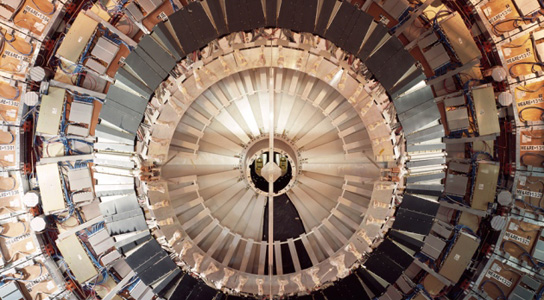
While Sherlock Holmes might have stated that the absence of any evidence is evidence itself, theoretical physicists haven’t yet been able to find any inkling to confirm supersymmetry (SUSY), a theory that predicts that every Standard-Model particle has a heavier partner. The reason why SUSY is so important is that it would be a step forward towards a grand unified theory of particles and forces.
The Higgs was the last missing particle of the Standard Model of Particle Physics, but this theory still has some major deficiencies, such as its silence on gravity and what makes up dark matter. At a conference in Kyoto last week, physicists working on the LHCb experiment, one of the four large detectors located around CERN’s Large Hadron Collider, announced results of an indirect search for new superparticles, known as sparticles. The team discovered an extremely rare process in which a BS meson, composed of a strange quark and a bottom antiquark, decays into a muon-antimuon pair. Only one in every 300 million BS mesons is predicted to do this because the decay relies on an unlikely chain of events, including a fleeting appearance of virtual particles. With the help of sparticles, this rate could increase hundredfold.
The LHCb team discovered that the BS meson behaves just as the Standard Model states it should, although more data is needed to confirm this. This could be problematic for the validity of SUSY. However, SUSY proponents aren’t worried, as it introduces 100 new adjustable parameters into the Standard Model.
Models of natural SUSY are looking hard to believe, states Brian Feldstein, of the Kavli Institute for the Physics and Mathematics at the University of Tokyo, Japan.
The ATLAS and CMS detectors at the LHC have seen no sign of sparticles, like squarks or gluinos, or any other particles outside the Standard Model. New updates indicate that the lightest sparticles, if they exist, should have masses of more than 1 TeV.
SUSY predicts the existence of four more Higgs particles with different masses, which have yet to be discovered. Next March, physicists will present results encompassing much more data gathered by the LHC, which will continue to fire protons until the 17th of December.
If nothing is found, then SUSY might remain in limbo until 2015, when the LHC will reopen after a shutdown and maintenance. At that time, the LHC will start colliding protons at energies of 13 TeV. So far, the LHC has operated at energies up to 8 TeV.
It’s possible that sparticles with masses of several TeV and higher might be too heavy to be produced in the LHC. One of the main reasons why physicists consider SUSY important is because it solves a problem in the Standard model, which predicts that the Higgs field should be ramped up to ridiculously high values by the fluctuations of Standard-Model particles. SUSY sparticles are supposed to cancel out these fluctuations, stabilizing the Higgs.
Sparticles could also become too heavy to be convincing candidates for dark matter, the unseen stuff that astronomers believe has a key role in shaping cosmic structure.
1 Comment
Standard Model of Particle Physics, defines three generations of fundamental particles , viz., up, down, electron and electron neutrino which is the first generation of particles still existing in the real world like you and me and the visible cosmos most stable. the second generation being strange, charm, muon and muon neutrino and the third being top, bottom, tau and tau neutrino which are all highly unstable and hence will soon disintegrate. But we cannot rule out that the complimentary pairs like positron etc are not existing since they are experimentally found. Hence Super Symmetry Theory cannot be buried by any scientist. Even so the Dark Matter and Dark Energy which occupy 96% of real universe cannot be dispensed with since they are experimentally and theoretically true. The elusive Higgs Boson is also 99% true due to 126Mev particle is statistically declared to be found. Only thing is that so many particles are highly unstable in the real world and SUSY or Super symmetry cannot be dumped at this stage. Thank You.